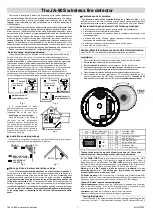
Antti-Teollisuus Oy
52
408116 03-2020
DRYING TECHNICS
During the drying process, you will face a lot of issues, that you should familiarise yourself with in advance.
Adjusting the temperature
1.
The primary means of raising the temperature is to increase the oil flow. The auxiliary nozzle of the 2-stage
burner will burn intermittently as long as additional heat energy will be required. If the nozzles, not even together,
cannot maintain the desired temperature, increase the feeding pressure or change the nozzles to larger ones.
These measures, however, are only applicable within the limits for the maximum oil flow allowed for the burner.
Refer to the heater manual for more detailed instructions.
2.
As the weather gets colder, you may have to make use of other methods of adjusting the temperature. The
next method to be applied for raising the temperature (after the maximum oil supply already is in use) is to
throttle the air flow. The air flow into the heater is reduced by means of a frequency transformer.
Grain variety
The setting of the thermostat and the outlet air temperature slightly vary from variety to variety. If the outlet air
temperature 37–38 °C corresponds to the moisture content of 14 % on wheat, the corresponding value for 2-row
barley is 38–39 °C, for 6-row barley and oat 34–35 °C , and for turnip rape 32–33 °C (moisture content 9 %). The
values may vary from farm to farm, but their order does not change.
Grass seeds
Drying grass seeds requires special arrangements. Tip the load into the filling hopper keeping pace with the eleva
-
tor. Moist seeds arch easily. The pre-cleaner shall not be used. The circulation speed can be the same as with the
grain. Throttle the flow of the drying air until the seeds no longer fly out of the drying section. Do not start the burner
until the moisture content has dropped under 25 %. After that you can keep the burner intermittently switched on
0.5–1 hours. Select the sizes of the nozzles so that the drying air temperature will not rise higher than 40–50 °C.
Towards the end, the temperature can be increased by 10 degrees.
Turnip rape and rape
The drying must ne commenced immediately after the harvesting. Too high drying air temperature spoils the quality
of the oil seeds. The upper limit of the temperature is about 65 °C provided that the circulation time is one hour.
The air flow must be limited so that only a non-significant amount of seeds will fly into the outlet air channel (in
terms of efficiency, slight "over flight" is, however, positive ).
Drying peas
Especially moist peas are difficult to dry. The drying time required is long so as to avoid damaging the surface. If
the moisture content is over 20 %, the drying air temperature must not exceed 40 °C. Towards the end, the tem
-
perature can be increased by about 10 °C, and/or an interval of 24 hours be kept to allow the moisture to even
out. If the peas are really moist, we recommend drying them at intervals, keeping the heat on for two hours, and
cooling for half an hour.
Summary of Contents for Plug&Dry
Page 10: ...Antti Teollisuus Oy 10 408116 03 2020 ...
Page 18: ...Antti Teollisuus Oy 18 408116 03 2020 ...
Page 22: ...Antti Teollisuus Oy 22 408116 03 2020 ...
Page 30: ...Antti Teollisuus Oy 30 408116 03 2020 ...
Page 32: ...Antti Teollisuus Oy 32 408116 03 2020 Dimensioning of the basic parts viewed from the side ...








































